Door closer - device type, selection, installation
No one likes slamming the door, but it must be closed tightly to avoid the outflow of heat from the room. For a noiseless process, a door closer is installed.
Such designs replace the installation of door springs, which closing the doors create a lot of noise. Types of devices, their features and methods of installation prompts article.
Device and principle of operation of door closers
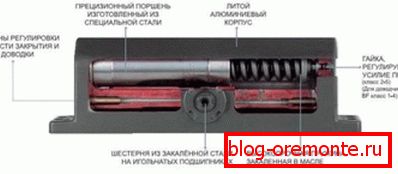
The main working element of any closer is a high-strength spring that enters the door cylinder to the closer. When opening the door, it compresses, accumulates energy, and when released, returns the door to its initial closed state.
For smooth closing of the opening in the closer there is an oil shock absorber. The built-in valve system facilitates the flow of oil when opening the doors from one chamber to another, and when closing back.
With their help, the speed of movement of the oil, and hence the speed of closing the doors, is regulated. The necessary smoothness of the process gives the viscosity of the damping fluid, it contributes to the silent closing of the door.
The design of the door closer can have one or more shock absorbers, which does not change the essence of the device. The working spring in different products is driven by its mechanism, which determines the type of closer.
Depending on the design when installing door breeders can solve several problems:
- Adjust the closing speed in two ranges - with acceleration when the doors are closed.
- Protect the canvas from hitting the obstacle.
- Secure the doors after opening them.
Device types
Types of door closers are classified by location, which can be:
- Top. Installed at the top of the door leaf. Different drive type:
- crank, in the design used coil spring and hydraulic piston, which are located in separate compartments. These are fairly simple devices that do not have the ability to control the movement of the door, or other changes. In demand for heavy doors;
- notched. This is the most common design, consisting of a gear gear that meshes with the piston and moves it along the axis when the door is torn off. When it is opened, the door closer moves in an arc. The part of the lever, screwed to the device body, is located perpendicular to the gear gear, the axis of which moves vertically through the door closer body. Gear teeth engage with piston teeth. Moving along the axis, the gear moves the piston in a horizontal position, clamping the spring. Energy is accumulated in the same way. Closing the door relaxes the spring, which presses on the piston in the opposite direction, rotating, the gear sends a lever to move the door structure, closing the door;
- with a sliding rod. This is not the most successful version of the design, in which there is no shoulder for transmitting a large force, which leads to not very reliable operation of the mechanism;
- cam shaft. The cam, having the appearance of a symmetrical or asymmetrical heart, also serves as an axis. When the door is opened, the element evenly compresses the spring with the opening piston. When closing, the spring expands, the opening piston moves in the opposite direction, returning the cam to its original position, the door slows down with the brake piston.
- Door Closers. Located in the floor. Installation of the closer of this type must be considered during the construction phase. The weight of the door holds the lower axis, which moves in the direction of another axis of rotation.
The design of the closer is used for doors weighing up to 300 kilograms.
- RAMS. This design is built into the frame or door frame, and its principle of operation is the same as the floor closers. In this case, the door weighs on the support, which is built into the floor. Rotation from the door closer's axis is transmitted to the door leaf through a lever built into the door from above. When the door is opened with a lever, the heart-shaped axis rotates. Depending on the direction when opening the door, it begins to put pressure on one of the rollers, which compresses the two springs. When you close the door, the whole process goes in the opposite direction.
According to the design of the product are divided into:
- Linear. In such a closer there is no knee or details for setting up the product.
- Knee. In the design there is a "knee", a canvas protruding when moving. These are the most reliable and simple devices among the lever mechanisms. There are two ways to mount:
- the casing of the driving mechanism is mounted on the door leaf, and the lever device is mounted on the box;
- possible and reverse mounting option.
Classification of mechanisms
To get acquainted with the existing door closers made in Russia, it is necessary to study GOST 5091-78. The main criteria by which the door closer is selected are the technical characteristics, or the efforts made by a person when closing the door.
According to GOST 5091-78 all door closers are divided into 7 classes:
- EN1. Used for sashes 750 millimeters wide and weighing up to 20 kg.
- EN2. The ideal device for cloths 850 millimeters wide and weighing up to 40 kg.
- EN3. Devices for sash width 950 millimeters, weighing up to 60 kg.
- EN4. Designed for canvases whose width is 1.1 meters, weighing up to 80 kg.
- EN5. Mounted on the sash width of 1.25 meters, weighing up to 100 kg.
- EN6. Adaptations of this class are designed for doors 1.4 meters wide, weighing up to 120 kg.
- EN7. Such mechanisms are ideal for canvases 1.6 meters wide, weighing up to 160 kg.
GOST 5091-78 indicates the force that must be applied when closing the door, measured in Nm (Newtonometers). The company “Door Closer” in its certificate for manufactured products, indicates the efforts in Nm. In this case, the models of mechanisms can be of the same class, and adjustable, with the ability to customize the application of force when opening doors.
In addition, GOST 5091-78 provides guidance on door closers for their work, taking into account the temperature working range. This is due to the fact that the oil used for lubricating the structure changes its viscosity under the influence of temperature. For outdoor use, it is recommended to install cold-resistant devices, using low-temperature oil, and special glands, which is contained in the product certificate.
GOST 5091-78 indicates another feature that should be taken into account when choosing a door closer for the door - the transmission of the rotating moment.
Device selection
Tip: Before you choose a door closer, you should get acquainted with the norms that define the efforts developed by the door closers when using them. They comply with European standards.
The big capacity of the closer corresponds to its higher class.
For example:
- The product of the highest class is selected for installation on an armored metal door.
- The low class closer is installed on a lightweight door product.
- Constructions of 3-5 grades are used for simple entrance doors installed in interior spaces.
When selecting a closer, the door parameters are taken into account, external factors are taken into account, for example:
- When operating the front door often exposed to side wind loads, the door leaf should be equipped with high-class products, which will increase the service life of the door closer.
Tip: If the size and weight of the door you can use two different classes of products, you should give preference to high-class elements, which will provide a greater margin of safety, and hence a longer device operation.
- Do not need to consider only the power when choosing a product. This does not always indicate a heavy load when mounted on a door. If such a closer is installed on the PVC door, an additional load on the hinges will be created, which will make them wear out quickly.
- A plastic door with powerful elements opens hard, this will create additional discomfort when using the door.
- When choosing a door closer for a door, its frost resistance should be taken into account. There are models that operate at extreme temperatures, ranging from (-45 ° C) to (+ 70 ° C).
- Attention is drawn to the speed of movement of the door system. For example, for fire protection structures, devices should have a high closing speed, and when used in a home, preference is given to slow closing, especially if there are children and the elderly in the home. In public places it is better to install devices with the function of braking the opening, which will prevent the sash from hitting the wall.
For acquaintance of the buyer with additional opportunities of a product the certificate on the closer door is offered. Its presence is a guarantee that the purchased product is of high quality.
Tip: When choosing a device, you should ask about the certificate. This will give greater confidence that the selected device will work properly for many years.
Overview of popular door closers
Below is an overview of the door closers of the most well-known foreign manufacturers of high-quality products:
- Door Closer Dorma. This is the mechanism of the German company, whose feature is the presence of sliding thrust. This design allows you to hide the knee of the traction mechanism, and not to spoil the appearance of the door.
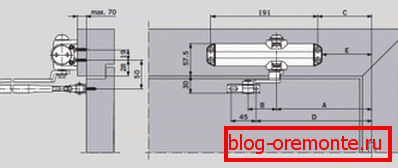
- Door Closers DC-100. This is a mechanical-hydraulic device for opening doors weighing up to 100 kilograms. It can work in the range of operating temperatures from (-35 ° C) to (+ 60 ° C), has two speeds of movement.

- Door closer 80 kg from the company Abloy. His company produces from Finland. Maximum door weight up to 80 kilograms. The model has a convenient mechanism for adjusting the mechanism. The design has an independent valve that allows for smooth movement of the door.
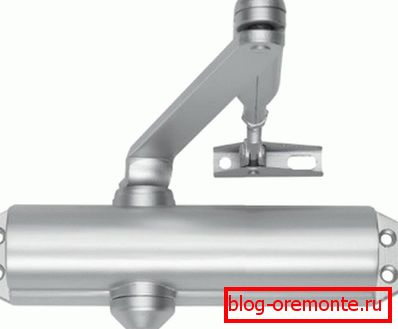
- GEZE Door Floor Closer not visible and reliably closes the doors of the pendulum and with emphasis. Systems are available for heavy valves and low weight designs. Closers can be installed on fire and smoke protection doors.
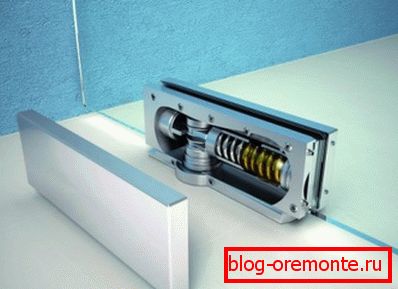
- Door closer up to 30 kg. The spring-loaded mechanical closer for doors DS19 serves for smooth closing of structures weighing up to 30 kg. They are distinguished by a single speed of movement of the door, adjustment by one screw. Used for doors that are up to 75 centimeters wide. The price of the product is the smallest.

- Door Closer "NORA-M". The minimum number of cycles of opening and closing the door is 500,000 times, the warranty on all models is valid for 5 years. In the range of the brand there are door closers “NORA-M”, the characteristic of which allows to fix the canvas in the open position. To close the door you need to bring the canvas to an angle of 90 °, and then it begins to close itself. In such models there is an adjustment of the closing speed of the structure and the speed of its survival.
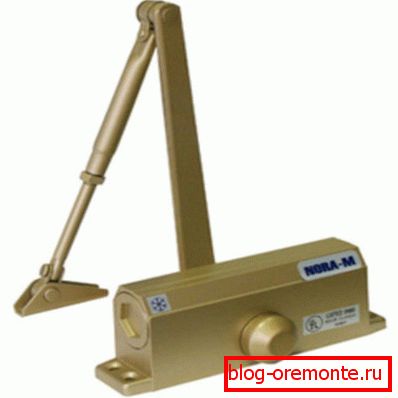
- Door closer "Bulat", it is intended for smooth, automatic closing of a door. Used for plastic, wooden and metal structures of canvases. Functions of devices: adjustment of speed of closing of a door, adjustment of speed of final finishing. The temperature range for use is from (-35 ° C) to (+ 50 ° C). Maximum door width - 1.2 meters.

- K-Dom Door Closers. Assembles a company from South Korea. The design has a standard lever. Serves for smooth closing of doors of oar type. Installation instructions in Russian, glands are made in Germany, the shaft has an enlarged diameter, special oil makes the construction frost-resistant, can work in the range from (-45 ° C) to (+ 50 ° C).

- Door closers for sliding doors. Such devices are often used in places of mass use: shops, hospitals, offices. The advantages and disadvantages of the device of such structures are shown in the table:
| Benefits | disadvantages |
| The main disadvantage of using such models is the presence of protruding spring-loaded pins, for which it is easy to catch and break the device. To prevent this, it is necessary to place the product at the highest points possible, but this may reduce the strength of the structure. |

Mounting mechanism
When purchasing a product that will be installed on the door with your own hands, you must bear in mind that the kit should include:
- Closer.
- The thrust of the levers.

- Hardware for fasteners.
- Scheme or drawings door closer for mounting structures.

Fittings can be installed on the input unit: on the box and on the canvas, depending on the purpose of the door structure.
Installation is:
- Internal, as in the photo. This is the most common way to install structures for external doors, while the product is mounted in the doorway.

- Outdoor
The full-size installation diagram included in the set allows you to install an accessory with high quality and avoid errors during installation.
For this:
- The installation scheme is taped on the door.

- Further actions are carried out according to the instructions offered by the instruction:
- Markup is done.
- Drilled holes.
- The case is attached.
- Mounted lever thrust.
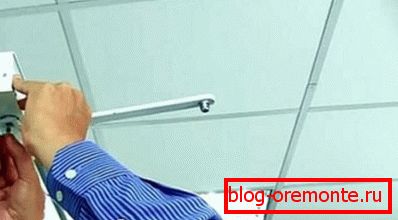
These are two halves, interconnected by threads.
- The lever is adjustable in length, which determines the angle of the door opening, approximately 90 °.
- With proper installation of all structural elements, the device will work efficiently, without failures.

In more detail installation of closers shows video in this article.
Closer setting
Correct adjustment of the installed elements can be performed if you deal with the screws that are part of the design for its adjustment.

Many models have special screws located on the decorative cover of their case. On some, the screws are located on the front side of the case and are labeled 1 and 2. The screw 1 adjusts the change in the opening angle of the door, it can reach 180 °. Screw 2 changes the speed of closing the sash.
When adjusting the door closer:
- The opening angle of the door leaf varies from 90 ° to 180 °.
- The acceleration of closing is adjusted by adjusting the screw 2.
- The door opens to the working angle and is released.
- Rotation of the screw 2 provides adjustment of the smoothness of the door leaf at the last 15 ° in order to ensure its reliable closing.
- Great effort in the implementation of the adjustment is not worth it.
- After 1/4 turn of the screw, the doors will close with a noticeable slowdown.

Closer can be used for a long time, if the setting will be done regularly. It must be borne in mind that the forced sticking of the doors for airing and supporting it with different objects may lead to an increase in the load on the glands and the closer piston.
This will cause the extrusion of oil from the body and the exit of the door closer out of order. To answer the question of how to fill the door closer correctly, only a specialist will help. Each design has its own characteristics.
Care for the door closer

To maximize the life of the door closer, you need to maintain the health of this mechanism, regularly check the status of its main parts:
- To avoid problems with the appearance of corrosion, regular metal fragments should be treated and lubricated for smoothness.
- It is necessary to periodically adjust the settings in accordance with the parameters of the door.
- You can not put anything under the open door.
- You can not pull the door "to", to accelerate this process.
- It is contraindicated to "help" the door to close, holding it.
Whether it will be a built-in door closer or any other type of it, with proper installation and operation of such a device will allow you to control the process of opening and closing doors. This will prevent the breaking of glass, and sometimes the falling out of the wall in the house when installing metal doors.